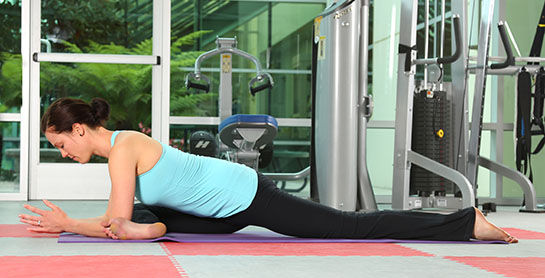
By Elizabeth Kovar
Whether you incorporate yoga poses into your group fitness classes or small-group or one-on-one trainings, it is essential that you understand how to safely adapt poses to suit the specific needs and limitations of your participants. Here's how to safely regress four common yoga poses.
Yoga and other mind-body modalities are highly effective for increasing strength, enhancing flexibility and promoting personal awareness. When appropriately modified, yoga can benefit a wide range of participants, from young to old, beginner to advanced.
The key, of course, is knowing when and how to modify or regress common yoga poses. Too often, the focus is on doing poses the “right” way, as opposed to doing what is most safe for participants.
Typically, the average participant comes to class with a wide range of limitations, including poor posture, an overweight body, stiff muscles and joints, and a lack of movement knowledge. Pushing novice or deconditioned participants to their edge, or to experience a deeper position, can easily lead to overforcing musculature, which may result in injury.
While it is appropriate to adjust misaligned body positions to reduce stress on joints, it is important to consider reducing the pushing or pressing of beginner bodies and instead start regressing yoga poses, which will allow clients and participants to:
- Physically and mentally connect to yoga training
- Grasp concepts and enhance physical awareness
- Lengthen tight musculature and connective tissue before moving into challenging poses
- Maintain and correct posture from a safe position
- Decrease the stress on the joints or spine
- Increase feelings of self-efficacy, enhancing the belief that they can perform the pose
Whether you incorporate yoga poses into your group classes or lead small-group or one-on-one training sessions, regressing poses makes them more accessible to your participants of all abilities and fitness levels. This may be particularly important for those who may be inclined push themselves further than their bodies are ready and able to go.
How to Safely Regress Yoga Poses
For Instructors: In a class setting, demonstrating two to three variations of a posture is an effective way to meet all levels. During pre-class announcements, communicate that, because there are various levels in the class, each student should be mindful of one's own body and to choose a level that fits one's current yoga ability.
Instructors can teach the class by demonstrating and cueing level one, two and possibly three. Or, you may choose to demonstrate and cue the position and signal various regression options. Participants who require a regressed pose may need additional guidance as to how to set up the posture and what he or she should experience. Larger classes may be more dependent on verbal cueing and visual demonstration, as you may not be able to assist each individual, especially if props are not available.
For Personal Trainers: Personal trainers may incorporate various levels to allow muscles to lengthen in an appropriate position. You also have the option of using self-myofascial release (SMR) or myofascial compression techniques (MCT) prior to implementing yoga poses to assist in the connective tissue–lengthening process.
An effective way to guide novice yogis into a better position is to use the “two finger rule.” This rule utilizes two fingers, either on one hand or one finger on each hand, to guide individuals to where you want them to go without forcing any positions.
Clients who are more limited in their movements require more “flexible” options from the instructor or trainer. There are countless ways to progress or regress yoga poses by altering focal points, foot and hand positions, and spinal movements. The “wrong” poses are those that encourage improper posture or positions that place joints in susceptible, stressed or dangerous positions.
The following yoga poses are often held incorrectly. Along with specific instructions for both instructors and trainers, you will be guided as to why participants may have difficulty with these positions and how to regress each pose.
1. Bound Angle Pose (Baddha Konasana)

Physical Benefits: Lengthens the inner thighs, primarily the gracilis and adductor longus
Reasons for Incorrect Posture:
- People may try to force the heels closer to the pelvis to feel “correct.”
- A person with a kyphotic spine increases its curvature the closer the heels get to the pelvis. In addition, the kyphotic spine presents rounded shoulders and forward-head posture. The hands on the feet enhance further rounding of the shoulders. Also, if adding a forward fold, too much emphasis is placed on the head reaching forward instead of the navel leading forward with an upright chest.
- Individuals with tight hip flexors and weak or tight hip external rotators may find difficulty in rotating externally, which is why the knees are also elevated. Integrating posture and tightness also leads to compensation, where a posterior pelvic tilt may occur and students may fight the feeling of sinking backwards.
Why Is Regression Necessary? Regression emphasizes spinal alignment and lengthens the anterior body to prepare for the upright or folded position.
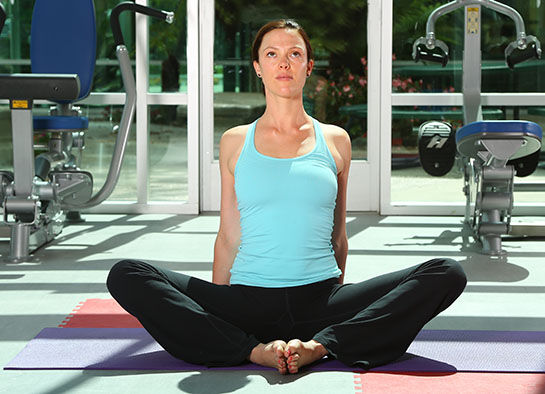
Regression (Instructor)
Allow the student to place their feet together with the heels approximately 12 to 18 inches away from the pelvis. Support the spine with the hands under the shoulders. The shoulders will be externally rotated with slight scapular retraction. Optional: Lift the heart and gaze toward the ceiling.
Regression (Personal Trainer)
Have the client sit with his or her spinal column against the wall. Engage the core and slowly allow the knees to naturally open to side of the body. Readjust as necessary to allow the back of the head, shoulder blades and part of the lumbar spine to rest against the wall. Optional: Place arms against the wall, or enhance shoulder mobility by gliding the arms up and down like “angel wings.” Watch for compensations of the thoracic spine to want to lift off the wall.
2. Low Lunge (Anjaneyasana)
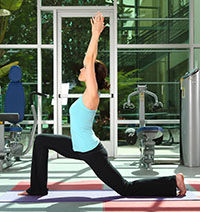
Physical Benefits: Primarily lengthens hip flexors and anterior chain of the body
Reasons for Incorrect Posture: People may “hang out” in the pose, which forces pressure onto the back leg and hip and allows the front leg to adduct and pronate at the foot as gravity pulls the body toward the floor without any active lifting. In other cases, it could be due to weaker gluteal muscles, which adduct the front leg.
Why Is Regression Necessary? The regression focuses on lengthening the anterior hip and teaches the body to become active in the pose and activate the front hamstring or lateral hip.

Regression (Instructor)
Encourage participants to place their hands on their hips to focus more on the leg rather than how high the hands can get. Place the hands lightly on the front leg and cue participants to press the front foot into the floor at the metatarsals and calcaneus. If activated correctly and lightly, they should be able to lift the toes.
Regression (Personal Trainer)
Allow the client to set up in the position without being “sunken” at capacity. Place a yoga strap around the lateral thigh and gently pull the strap while the client resists the pulling. This activates the hamstrings, quadriceps and hip external rotators so the pose is strong and lifted without the forward collapse.
3. Extended Triangle Pose (Utthita Trikonasana)
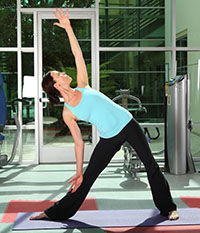
Physical Benefits: Lengthens the front leg inner thigh and top, lateral hip and oblique region.
Reasons for Incorrect Posture:
- Too often, participants are focused on reaching the hand toward the foot to achieve a “correct” posture.
- Depending on how close or far away the feet are positioned, a lack of mobility in the hips may lead to incorrect posture.
- If the individual is obese, his or her center of mass is off balance and the abdominal mass pulls the spine forward.
Why Is Regression Necessary? The regression lengthens the inner thighs and contralateral hip and oblique, while supporting the spine in lateral flexion before progressing to the full triangle.
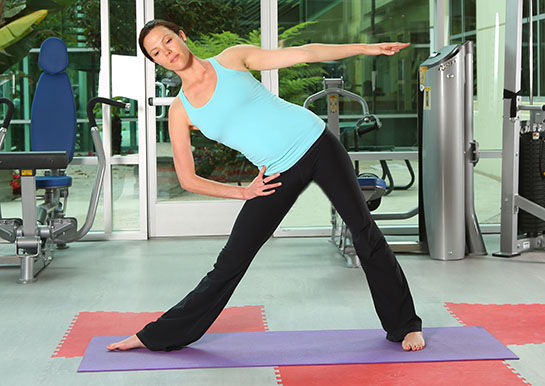
Regression (Instructor)
When in the triangle position, place the bottom hand near the ASIS joint and oblique. Cue participants to engage the pelvic floor and abdominals. Once they feel the contraction, laterally flex the spine with the arm remaining level with the shoulder. A minor progression is to bring the biceps over the ear to further enhance the side body and posterior arm stretch.
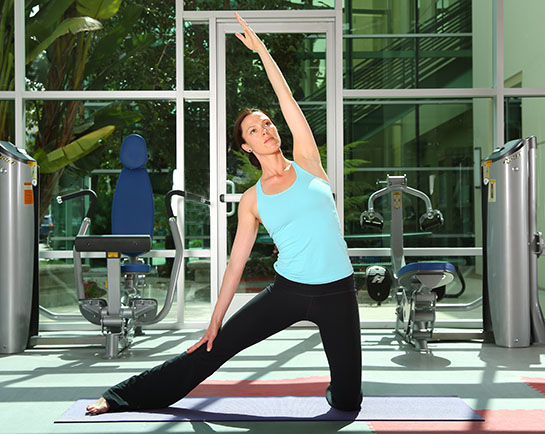
Regression (Personal Trainer)
An effective regression is to implement the gate-latch pose. This is similar to triangle, but with a short lever of one leg. Align the client on his or her shin, with the opposite leg extended and toes pointing forward. Reach the hand down the extended leg and raise the opposite arm overhead as the client laterally flexes the spine. This teaches the client to be strong while lengthening without the body collapsing into the pose.
4. Pigeon Pose—Prone (Eka Pada Rajakapotasana Variation)
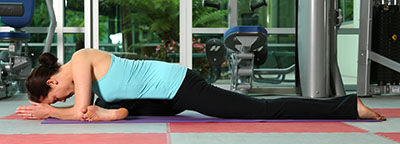
Physical Benefits: Lengthens the hamstrings and external rotators of the forward leg and psoas major of the extended leg
Reasons for Incorrect Posture: Lack of mobility and flexibility in the hip region and within the kinetic chain prevents the individual from maintaining a neutral pelvis and forward-flexed state.
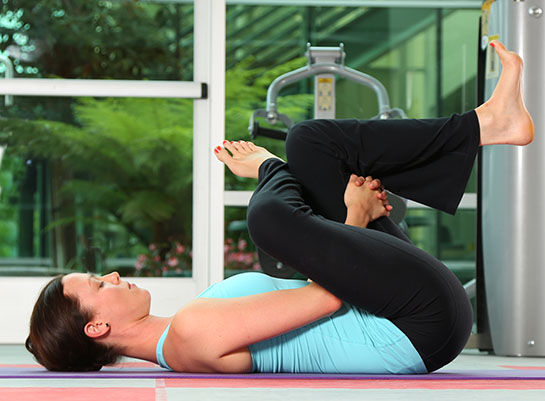
Regression (Instructor or Personal Trainer)
One of the most effective regressions for class participants and clients is to place the body in a supine pose, and cross one shin over the opposite leg at a 90 degree angle. Have the client place his or her hands on the hamstrings and inner thigh and softly apply pressure to allow for a “deeper” lengthening process.
______________________________________________________________
 Elizabeth Kovar is a Mind-Body Movement Specialist and a Master Trainer Presenter for the American Council on Exercise. She has had the opportunity to study yoga in five different countries, with her main coursework coming from India and learning the Ashtanga yoga philosophy. She lives in Seattle, Wash., and is a trainer, instructor, freelance writer and workshop presenter. www.elizabethkovar.com
Elizabeth Kovar is a Mind-Body Movement Specialist and a Master Trainer Presenter for the American Council on Exercise. She has had the opportunity to study yoga in five different countries, with her main coursework coming from India and learning the Ashtanga yoga philosophy. She lives in Seattle, Wash., and is a trainer, instructor, freelance writer and workshop presenter. www.elizabethkovar.com